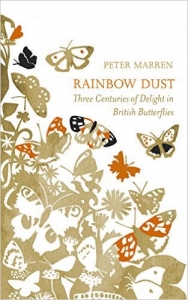 |
by Peter Marren
From the publisher:
Much more than just another field guide or a natural history of butterflies Rainbow Dust explores the ways in which butterflies delight and inspire us all, naturalists and non-naturalists alike. Beginning with the author's own experience of hunting and rearing butterflies as a boy, Peter Marren considers the special place of the butterfly in art, literature, advertising and science, and, latterly, our attempts to conserve them. Rainbow Dust takes in the controversy over collecting, the women who studied them and the curious details that lead to butterflies being feared as well as loved. This is a celebration of butterflies; one shot through with a sense of wonder but also of sorrow at what we are losing.
The introduction to the book spells out the author's aims: "This book is my attempt to write a personal 'cultural life' of British butterflies and to try to give a sense of their lasting appeal". The author achieves this without a doubt, by taking us on a journey through topics as varied as collecting, butterfly names, art and even our imagination. In the introduction we discover that the title of the book harks back to the author's childhood when he rubbed butterfly scales between his fingers, producing "Rainbow Dust".
The book starts with a chapter on "Meeting the Butterfly", which is an introduction to butterflies aimed at those who, I assume, know very little about them - discussing topics such as how to distinguish butterflies and moths, a butterfly's lifecycle, and ending with more intricate topics such as the association that some butterfly species have with ants, and the mysteries of migration.
The subsequent chapters are beautifully written and researched, making for a very easy read. I rattled through this 308-page work in next to no time, enjoying every minute. The three chapters on collecting are a particularly nice summary of this sensitive subject, from its roots up to the present day. Those wanting to debate this topic would do well to read them.
I must admit that I really struggled to understand the connection from one chapter to the next, giving the impression of a number of independent essays, and this was compounded by the rather vague chapter titles. A list of chapters is given below, with my interpretation (where needed) shown in parentheses, which should provide a sense of the book's content.
Some connections are made between chapters but I, for one, wish that they'd been spelled out more clearly. For example, Sir Walter Rothschild was a prodigious collector (a connection to chapters 2-4) and his niece, Miriam (a connection to chapter 5), a well-known naturalist in her own right. It's a bit like watching a Quentin Tarantino film that jumps between concurrently-running scenes, where you don't see the overall picture until the end.
That aside, I would recommend this book on the basis of the detailed research that sits behind each chapter; I learned quite a few things along the way, including the true origins of the use of "Admiral" (as in the Red and White Admiral butterflies), and it's not what I'd been led to believe in all of the (many) other butterfly-related books I've read. This is a book that I know I'll dip into from time to time. Thoroughly researched. Exquisitely written.
The book is available through all good book stores, from online stores, and also the publisher, Random House.